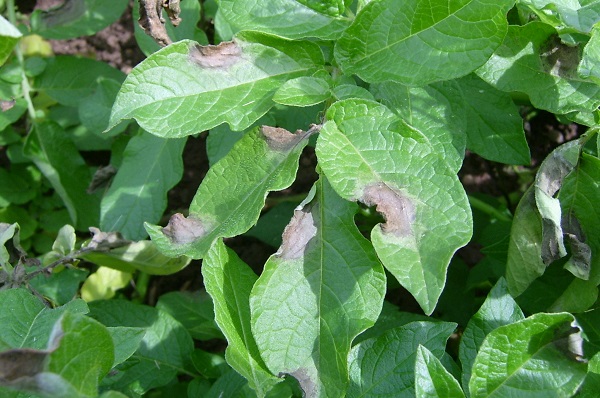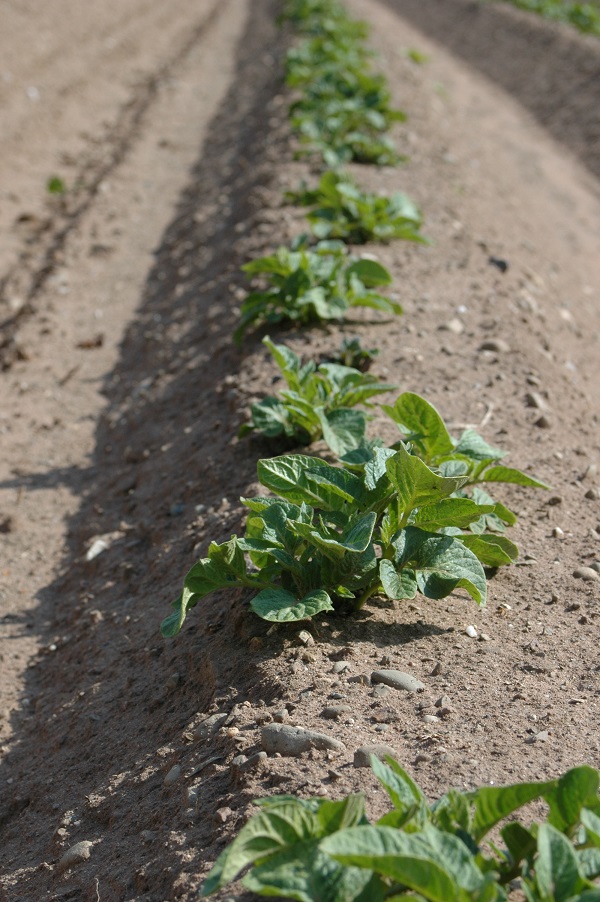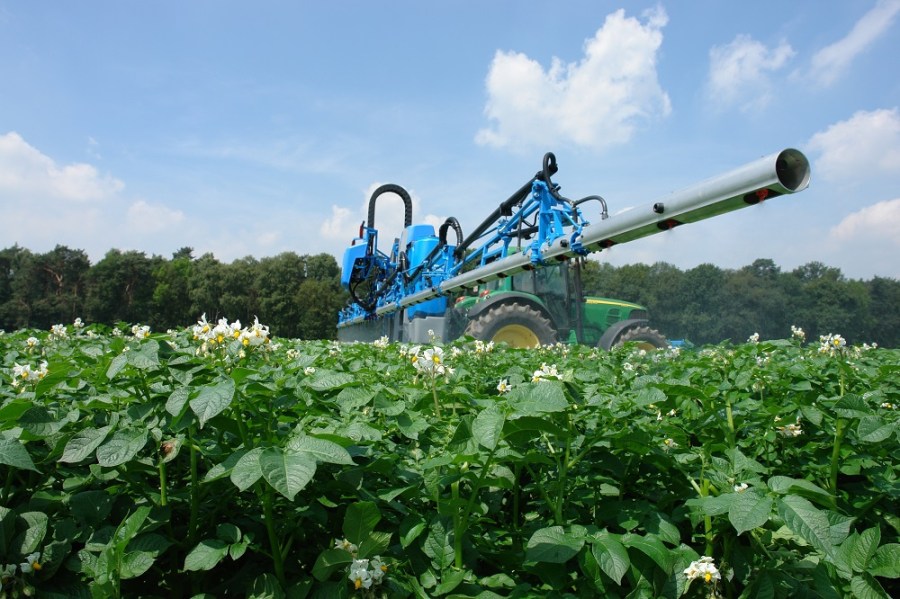With blight populations remaining stable, CPM asks a Herefordshire agronomist for his tips on a successful strategy against the disease.
Remember that you need to be ahead of the disease.
By Lucy de la Pasture and Rob Jones
Early vigilance and planning is crucial for success, as blight population shifts have been responsible for the disease coming into crops earlier and hitting them harder in recent years, warns Andrew Goodinson, western area business manager with Hutchinsons.
As a result, effective control strategies are based on making an early start, keeping to tight spray intervals and choosing the right fungicide products for each stage of the programme, he advises.
And part and parcel to starting early is staying ahead of the game by having blight fungicides in stock in advance of the first disease warning. This means growers can react quickly to any changes in the weather and plan around irrigation scheduling.

The new Hutton Criteria should help growers stay ahead of blight.
“The good news is that we do have the armoury to control blight. And even though we must remain vigilant for new, more aggressive strains of the disease, monitoring work has shown that the situation in the UK remains fairly stable,” he comments.
Andrew Goodinson points to results from the James Hutton Institute which show that last year’s potato blight outbreaks were mostly caused by two dominant strains of the pathogen, Pink 6_A1 and Blue 13_A2, both of which UK growers were already familiar with from previous years.
“Unlike the situation in other parts of Europe, not much has changed in UK blight populations over the past couple of seasons, with little diversity found in samples received from crops across England.
“That makes it easier for growers to plan their control programmes and manage the threat of disease. For now, it’s about the devil we know, rather than a new enemy.”

Make sure fungicides are in stock in advance of the first blight warnings.
Even so, any blight control strategy has to address the ability of the disease to build up very rapidly in the right conditions, he advises.
“This year, we have the new Hutton Criteria to help us forecast outbreaks, which should be helpful and a bit more reliable. The main change from the Smith Period system is the number of hours of relative humidity at 90% or above, which has been reduced to six hours (from 11 hours).”
As well as forecasting systems, he uses potato dumps as key indicators of the start of blight epidemics and relies on his Cornish colleagues to forewarn him of any disease found in early crops produced under plastic.
“We tend to see the first outbreak in June, as temperatures rise. And although there are some differences in varietal susceptibility, they all need spraying.”
Blight programmes should start at the rosette stage and then continue at seven day intervals, if required, with products being chosen according to the stage of crop development.
“You need to have fluazinam in the first sprays, as it protects the new growth. It gets blight management off to a good start at a reasonable price,” he says.
Ranman Top (cyazofamid) is a good fit as rapid haulm growth occurs, as it is also protectant in nature and offers good rainfastness. It has also shown good efficacy on new growth and tubers, he continues.
“It’s a very useful product to include just before and at the stable canopy phase. It also has a place at the end of blight programmes, where it seems to help with the activity of the desiccant,” he notes.
Once crops are at the stable canopy phase, growers may need to consider the use of systemic products which are mobile in the plant, advises Andrew Goodinson. Active ingredients such as dimethomorph, with their limited curative activity, have a role where spray intervals get stretched in adverse weather conditions.
“As the season develops, it’s a good idea to alternate product choice for foliar blight and stem/tuber blight. Remember that you need to be ahead of the disease, so you don’t want to become too reliant on the kick-back activity that products such as cymoxanil provide.”
Kunshi (cymoxanil+ fluazinam), which was introduced in 2015, is a good mix of two active ingredients offering curative and multi-site activity – cymoxanil and fluazinam – and can be used on its own or in mixes with other materials, he finds.
“It’s been a good addition for high pressure situations or where blight is active. The cymoxanil component moves through the leaf, while the fluazinam offers stem blight control.
“Kunshi has also been shown to reduce the number of active blight spores, so it has an anti-sporulant effect. It works very well where there’s a need to keep varying products in a programme and make the best use of actives.”
His final advice is for growers to keep adjuvant with them, especially where they have to travel some distances in the sprayer.
“If rain is forecast, put a ‘sticker’ into the tank. It really helps with rainfastness,” he concludes.
Lions roar warning for Alternaria spray timing
Wimbledon tennis tournament has announced its latest start since 1895 this year, commencing on 3 July. For potato growers who have traditionally started alternaria prevention treatments to coincide with the second week of the competition, it could be too late this season, according to Syngenta field technical manager, Douglas Dyas.
For a sporting start to the treatment programme, he suggests growers should forget the tennis and follow the roar of the British Lions in New Zealand. The first rugby Test on 24 June could be far more appropriate to kick off the alternaria spray scheduling.
Though he’s quick to point out not to go by date alone, and advocates growers should also take account of other risk factors; such as variety, soil type, irrigation, nutrition and previous history of disease, to assess the start timing to their alternaria programme.
“All the research and experience, in the UK and Europe, is that alternaria fungicide treatments have to be applied preventatively. That means keeping ahead of infection and protecting crops through periods of stress when they are most susceptible to attack,” advises Douglas Dyer.
He believes that this season, growers have a significant advantage for disease control, with the approval for Amistar (azoxystrobin) for alternaria control.
“There’s the chance to significantly extend the control window, with initial use of Amphore Plus (difenoconazole+ mandipropamid), followed by inclusion of Amistar in the early blight programme.”
Douglas Dyer also highlights that extended prevention of alternaria infection to stop early leaf senescence, could prove especially important this season on crops that have been relatively late to emerge in dry conditions and cool soils.
“We’ve seen that even low levels of infection, which may appear to cause minimal damage, can potentially allow more virulent strains of the pathogen to attack later in the season and cause rapid leaf defoliation with subsequent loss of crop yield and tuber quality,” he warns.
Initial treatments with Amphore Plus target earlier infections of the pathogen, particularly the strain A. alternata. By applying a higher rate of 150 g/ha difenoconazole in each application, it rapidly builds up important protection, while a full rate of mandipropamid (Revus) co-formulated in the product provides late blight protection.
“Growers and agronomists can then switch to Amistar for its proven efficacy on A. solani, which testing by Syngenta and NIAB, in conjunction with leading UK independent agronomists, has shown to typically come in slightly later in the season,” he adds.
New app sizes up potato prospects
Potato growers could find sizing potatoes from test digs much easier in the future thanks to a new mobile app developed by the James Hutton Institute and Agrovista.
Analysing tuber size from test digs is an important process that enables growers to manage burn down/haulm destruction strategies to optimise tuber size, ensuring crops meet market requirements and so maximise profits.
Until now, this has involved riddling tubers through multiple sieves and grading according to size. The PotatoSize app replaces this laborious process, using cutting-edge automated analysis of pictures of tuber samples taken by growers. It provides accurate results within minutes, says Lewis McKerrow, Agrovista’s head of precision technology.
“This allows quick and easy assessment of crop statistics, including crop weight in 5mm size bands (t/unit), current estimated crop weight per area (eg t/ha) and an easy-to-read bar graph of size bands.
“The app provides growers with the information they need to achieve accurate, consistent results across crops and sites,” he explains.
“Growers can now forget about using cumbersome riddles and sizing grids. In addition, larger organisations benefit from the ability to get consistent results from different staff across multiple locations, as well as the ability to export results back to a central point.”
The app contains detailed information on how to prepare a sample and take a photo of the potatoes. Growers can assess crops using the following simple steps:
- Dig a measured length of row
- Organise potatoes uniformly on the soil
- Place reference sheets beside the potatoes
- Take a picture
- Press process
- Wait a few minutes for the results.
PotatoSize is available for iOS and Android devices and can be downloaded from the App Store and Google Play store.
Managing risk of water shortages
With changes to irrigation abstraction licences on the horizon, a new webtool, currently in development, aims to help businesses assess and manage their risks when water is in short supply.
The April drought was a timely reminder of the importance of water in potato production. As part of the abstraction reform process, the Environment Agency (EA) is proposing to change the conditions of agricultural spray irrigation time-limited licences (TLLs) as they are due for renewal. These conditions would reduce the amount of water licensed for abstraction in order to meet environmental flow objectives set by the Water Framework Directive (WFD).
For many potato and field vegetable growers, these proposed changes could have major consequences on their ability to fulfil retailer demands for premium quality produce, especially when rainfall is insufficient and crops are at risk from drought conditions, explains Prof Ian Holman, expert on integrated land and water management at Cranfield University.
“Recent work at Cranfield as part of the Natural Environment Research Council’s (NERC) ‘Drought and Water Scarcity’ Programme demonstrated that the total on-farm net benefit of irrigation in England and Wales in a ‘design’ dry year is over £650 million, demonstrating the substantial business risk that a lack of irrigation water can pose to farmers,” he says.
“It’s important to stress that this figure excludes the substantial ‘added value’ that is accrued along the supply chain, further reinforcing the importance of water in food production,” he adds.
However, whilst the UK is typically considered a ‘wet’ region for food cropping, agribusinesses involved in high-value agricultural and horticultural production, such as potatoes and field-vegetables, are not immune to the effects of drought or future changes to licence conditions.
“Managing the business risk of having insufficient irrigation water to meet crop needs will therefore become increasingly important,” he explains.
In response to this, Cranfield University, in collaboration with the UK Irrigation Association, NFU and selected growers in the Cam and Ely Ouse catchment (Elveden Estate, Euston Estate, Frederick Hiam Ltd and WO & PO Jolly), have been awarded NERC Innovation funding to co-design and develop a farmer-friendly “D-Risk” a decision support webtool.
“This will enable growers to understand and manage current and future drought risk to their irrigated cropping,” says Ian Holman.
Although the EA originally planned to take immediate action on TLL reform, with ramifications of Brexit it appears that implementation may be delayed.
“This provides us with a timely and valuable opportunity to support businesses in understanding the repercussions of the proposed reforms for the future drought risk management on their farming enterprises,” he comments.
“The D-Risk tool will enable farm businesses to quickly and easily evaluate their current drought risk by entering information on their farm location, cropping plans, abstraction licences and water storage capacity,” explains Ian Holman.
“It will also allow growers to conduct ‘what if’ scenario analyses to assess the consequences of farm business adaptation to their drought risk. For example, modifying their cropping plans, irrigation schedules or water resource availability (through increased winter reservoir storage, water trading or reducing licence volumes).”
The D-Risk tool, which will be freely available through the internet and promoted through the UKIA, NFU and water abstractor groups such as ESWAG in Suffolk, is expected to be launched in late 2017.




